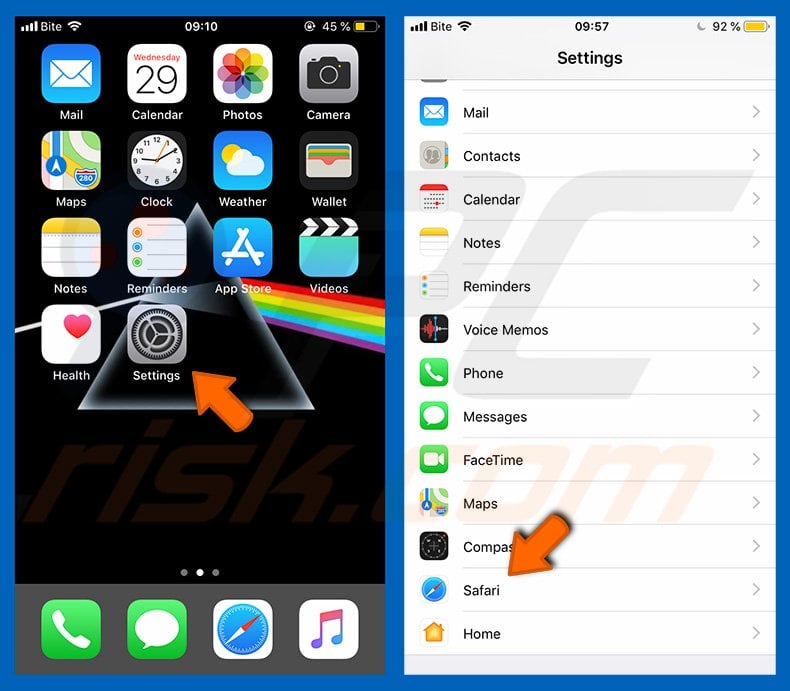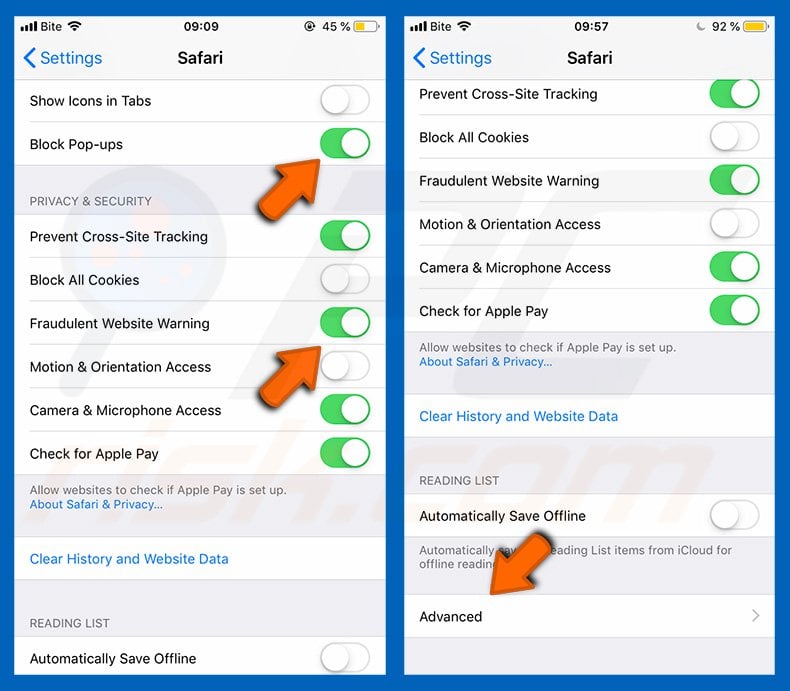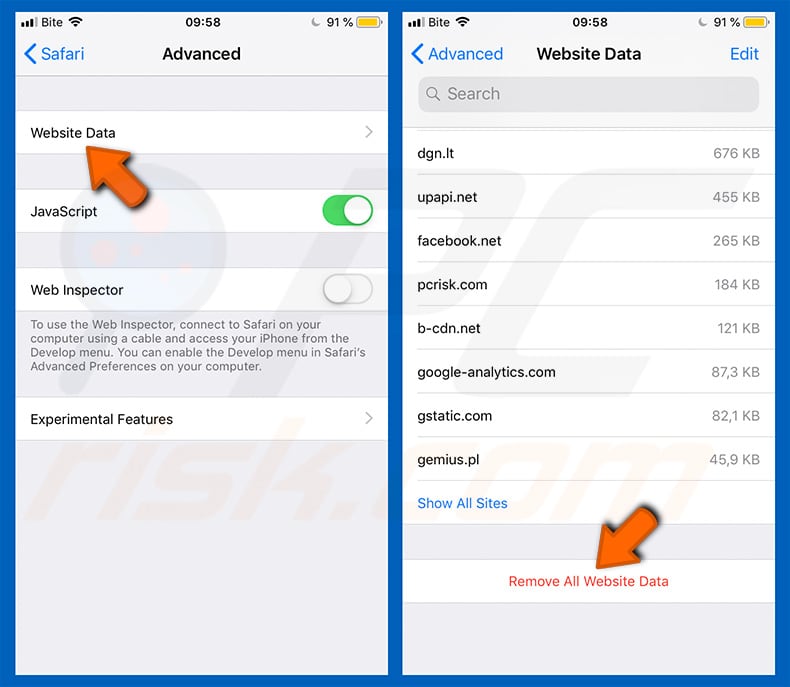Do not trust content or apps promoted via ios-protect-defence.com
Mac VirusAlso Known As: ios-protect-defence.com pop-up
Get free scan and check if your device is infected.
Remove it nowTo use full-featured product, you have to purchase a license for Combo Cleaner. Seven days free trial available. Combo Cleaner is owned and operated by RCS LT, the parent company of PCRisk.com.
What is ios-protect-defence[.]com?
Ios-protect-defence[.]com is a deceptive website that promotes various scams. At the time of research, this web page promoted a scheme targeting iPhone users, however, it is possible that users of other Apple devices could likewise inadvertently enter the site. The scam claims that visitors' mobile devices are infected and urges them to download/install the endorsed app.
Typically, schemes of this kind promote various potentially unwanted applications (e.g. fake anti-viruses, adware, browser hijackers, etc.) and some might even promote malware (e.g. Trojans, ransomware, etc.). Most users access deceptive web pages via mistyped URLs, redirects caused by intrusive ads or by Potentially Unwanted Applications (PUAs).
This software does not require explicit consent to be installed onto systems, and thus users may be unaware of its presence.
![ios-protect-defence[.]com scam](/images/stories/screenshots202012/ios-protect-defence-com-scam-main.jpg)
The scam run on ios-protect-defence[.]com displays a fake notification (pop-up window), which states that the visitor's iPhone has been compromised and this requires immediate action. Once this pop-up is closed, the background page is brought forth. The text presented in the page claims that the device has been infected with a Trojan virus.
Supposedly, this infection has already caused 17% damage to the mobile phone's memory. If this nonexistent issue is not addressed, the device might become permanently damaged and its privacy, compromised.
According to the scheme, users' accounts, photos, financial/payment data (i.e. banking account and credit card details) might be exposed to third parties (e.g. cyber criminals). To remove the fake threats, the scam urges users to download/install a "trustworthy" application, which will allegedly remove the malware and secure the phone.
It must be emphasized that no website can actually detect threats/issues present on visitors' devices - any that make such claims are scams. The purpose of these schemes is to promote untrustworthy and possibly malicious software.
To summarize, by trusting the deceptive content promoted on ios-protect-defence[.]com, users can experience system infections, severe privacy issues, financial losses and even identity theft. PUAs are commonly advertised via deceptive/scam sites.
This software often seems legitimate and offers a wide variety of "useful" functionalities, however, the promised functions are rarely operational. Fake anti-virus tools are a prime example of this kind of PUA. Bogus anti-virus software requires activation (i.e. purchase) to perform their advertised features, yet even after activation, they remain nonoperational.
These unwanted applications can have varied dangerous capabilities and these functions can be in different combinations. PUAs can force-open dubious, misleading, deceptive/scam and malicious websites (including ios-protect-defence[.]com). Adware-type apps deliver intrusive advertisements (e.g. pop-ups, banners, surveys, etc.), which seriously diminish the browsing experience.
Furthermore, when clicked, these ad redirect to various dangerous web pages and some can even stealthily download/install software. Other PUAs called browser hijackers modify browser settings and restrict/deny access to them to promote fake search engines.
The promoted web searchers are rarely able to provide search results, and so they tend to redirect to Google, Bing, Yahoo and other genuine search engines. Furthermore, most PUAs (regardless of type) have data tracking abilities. Information of interest includes (but is not limited to) browsing and search engine histories, IP addresses, geolocations, and other personally identifiable data. The gathered information is then monetized by sharing with and/or selling to third parties (potentially, cyber criminals).
To ensure device integrity and user privacy, all suspicious applications and browser extensions/plug-ins must be eliminated immediately upon detection.
| Name | ios-protect-defence.com pop-up |
| Threat Type | Phishing, Scam, Mac malware, Mac virus. |
| Fake Claim | Scam claims visitors' iPhones are infected and must be repaired immediately. |
| Promoted Unwanted Application | Various dubious applications. |
| Serving IP Address | 64.225.2.103 |
| Symptoms | Your Mac becomes slower than normal, you see unwanted pop-up ads, you are redirected to dubious websites. |
| Distribution methods | Deceptive pop-up ads, free software installers (bundling), fake Flash Player installers, torrent file downloads. |
| Damage | Internet browser tracking (potential privacy issues), display of unwanted ads, redirects to dubious websites, loss of private information. |
| Malware Removal (Windows) |
To eliminate possible malware infections, scan your computer with legitimate antivirus software. Our security researchers recommend using Combo Cleaner. Download Combo CleanerTo use full-featured product, you have to purchase a license for Combo Cleaner. 7 days free trial available. Combo Cleaner is owned and operated by RCS LT, the parent company of PCRisk.com. |
Moderation-support.network, apple.global-support.space, brkdown.com and umobile-security.com are some examples of other deceptive pages that target iPhone users. The web is full of scams, which use a broad range of techniques to gain and abuse users' trust.
Popular scam models include: warnings that the device is or may be infected, notifications about essential software being outdated or missing, fake prize raffles, "amazing" offers and deals, etc. The purpose of these scams is to generate revenue for their designers. Due to the relative prevalence of these sites, you are strongly advised to exercise caution when browsing.
How did potentially unwanted applications install on my computer?
PUAs are often downloaded/installed together with other products. This deceptive marketing technique of pre-packing regular software with unwanted or malicious additions is called "bundling". By rushing through download/installation of software (e.g. ignoring terms, skipping steps and sections, using "Quick/Express" settings, etc.) many users risk unintentionally allowing bundled content into their devices.
Intrusive advertisements proliferate PUAs as well. When clicked, the ads can execute scripts to download/install these applications without users' permission.
Some PUAs have "official" download web pages from which they can be downloaded.
How to avoid installation of potentially unwanted applications?
You are advised to research all software before download/installation. Use only official and verified download channels. Unofficial and free file-hosting websites, Peer-to-Peer sharing networks (BitTorrent, Gnutella, eMule), and other third party downloaders commonly offer harmful and bundled content, and are therefore untrusted and should be avoided.
When downloading/installing, read the terms, study all possible options, use the "Custom/Advanced" settings and opt-out of additional apps, tools, features, and so on. Intrusive advertisements typically seem legitimate, however, they can redirect to dubious and malicious sites (e.g. gambling, pornography, adult-dating, and many others). If you encounter ads or redirects of this kind, inspect the system and remove all dubious applications and browser extensions/plug-ins immediately.
If your computer is already infected with PUAs, we recommend running a scan with Combo Cleaner Antivirus for Windows to automatically eliminate them.
Text presented in the pop-up window displayed by ios-protect-defence[.]com scam website:
YOUR IPHONE HAS BEEN COMPROMISED
Immediate Action Is Required!
OK
Appearance of the scam's background page:
![ios-protect-defence[.]com scam background page](/images/stories/screenshots202012/ios-protect-defence-com-scam-background-page.jpg)
Text presented in this page:
Apple Security
Monday
7 December 2020
Important notice. Your device is currently infected with a Trojan virus!
Your phone's memory is already having 17% of damage. Prompt action is required, otherwise,
the device will become defective and all your data including accounts, photos, and payment data will be available to third parties.
Immediately install the trusted free app from the AppStore to remove the virus and secure your device.
1 minutes and 39 seconds
Remove Virus
Detected By Apple.
To enable pop-up blocking, fraudulent website warnings, and remove web browsing data in mobile Apple devices, follow these steps:
First, go to "Settings", and then scroll down to find and tap "Safari".

Check if the "Block Pop-ups" and "Fraudulent Website Warning" toggles are enabled. If not, enable them immediately. Then, scroll down and tap "Advanced".

Tap "Website Data" and then "Remove All Website Data".

Instant automatic malware removal:
Manual threat removal might be a lengthy and complicated process that requires advanced IT skills. Combo Cleaner is a professional automatic malware removal tool that is recommended to get rid of malware. Download it by clicking the button below:
DOWNLOAD Combo CleanerBy downloading any software listed on this website you agree to our Privacy Policy and Terms of Use. To use full-featured product, you have to purchase a license for Combo Cleaner. 7 days free trial available. Combo Cleaner is owned and operated by RCS LT, the parent company of PCRisk.com.
Quick menu:
- What is "ios-protect-defence[.]com"?
- STEP 1. Remove PUA related files and folders from OSX.
- STEP 2. Remove rogue extensions from Safari.
- STEP 3. Remove rogue add-ons from Google Chrome.
- STEP 4. Remove potentially unwanted plug-ins from Mozilla Firefox.
Video showing how to remove adware and browser hijackers from a Mac computer:
Potentially unwanted applications removal:
Remove potentially unwanted applications from your "Applications" folder:

Click the Finder icon. In the Finder window, select "Applications". In the applications folder, look for "MPlayerX","NicePlayer", or other suspicious applications and drag them to the Trash. After removing the potentially unwanted application(s) that cause online ads, scan your Mac for any remaining unwanted components.
DOWNLOAD remover for malware infections
Combo Cleaner checks if your computer is infected with malware. To use full-featured product, you have to purchase a license for Combo Cleaner. 7 days free trial available. Combo Cleaner is owned and operated by RCS LT, the parent company of PCRisk.com.
Remove adware-related files and folders

Click the Finder icon, from the menu bar. Choose Go, and click Go to Folder...
 Check for adware generated files in the /Library/LaunchAgents/ folder:
Check for adware generated files in the /Library/LaunchAgents/ folder:

In the Go to Folder... bar, type: /Library/LaunchAgents/

In the "LaunchAgents" folder, look for any recently-added suspicious files and move them to the Trash. Examples of files generated by adware - "installmac.AppRemoval.plist", "myppes.download.plist", "mykotlerino.ltvbit.plist", "kuklorest.update.plist", etc. Adware commonly installs several files with the exact same string.
 Check for adware generated files in the ~/Library/Application Support/ folder:
Check for adware generated files in the ~/Library/Application Support/ folder:

In the Go to Folder... bar, type: ~/Library/Application Support/

In the "Application Support" folder, look for any recently-added suspicious folders. For example, "MplayerX" or "NicePlayer", and move these folders to the Trash.
 Check for adware generated files in the ~/Library/LaunchAgents/ folder:
Check for adware generated files in the ~/Library/LaunchAgents/ folder:

In the Go to Folder... bar, type: ~/Library/LaunchAgents/

In the "LaunchAgents" folder, look for any recently-added suspicious files and move them to the Trash. Examples of files generated by adware - "installmac.AppRemoval.plist", "myppes.download.plist", "mykotlerino.ltvbit.plist", "kuklorest.update.plist", etc. Adware commonly installs several files with the exact same string.
 Check for adware generated files in the /Library/LaunchDaemons/ folder:
Check for adware generated files in the /Library/LaunchDaemons/ folder:

In the "Go to Folder..." bar, type: /Library/LaunchDaemons/

In the "LaunchDaemons" folder, look for recently-added suspicious files. For example "com.aoudad.net-preferences.plist", "com.myppes.net-preferences.plist", "com.kuklorest.net-preferences.plist", "com.avickUpd.plist", etc., and move them to the Trash.
 Scan your Mac with Combo Cleaner:
Scan your Mac with Combo Cleaner:
If you have followed all the steps correctly, your Mac should be clean of infections. To ensure your system is not infected, run a scan with Combo Cleaner Antivirus. Download it HERE. After downloading the file, double click combocleaner.dmg installer. In the opened window, drag and drop the Combo Cleaner icon on top of the Applications icon. Now open your launchpad and click on the Combo Cleaner icon. Wait until Combo Cleaner updates its virus definition database and click the "Start Combo Scan" button.

Combo Cleaner will scan your Mac for malware infections. If the antivirus scan displays "no threats found" - this means that you can continue with the removal guide; otherwise, it's recommended to remove any found infections before continuing.

After removing files and folders generated by the adware, continue to remove rogue extensions from your Internet browsers.
Remove malicious extensions from Internet browsers
 Remove malicious Safari extensions:
Remove malicious Safari extensions:

Open the Safari browser, from the menu bar, select "Safari" and click "Preferences...".

In the preferences window, select "Extensions" and look for any recently-installed suspicious extensions. When located, click the "Uninstall" button next to it/them. Note that you can safely uninstall all extensions from your Safari browser - none are crucial for regular browser operation.
- If you continue to have problems with browser redirects and unwanted advertisements - Reset Safari.
 Remove malicious extensions from Google Chrome:
Remove malicious extensions from Google Chrome:

Click the Chrome menu icon ![]() (at the top right corner of Google Chrome), select "More Tools" and click "Extensions". Locate all recently-installed suspicious extensions, select these entries and click "Remove".
(at the top right corner of Google Chrome), select "More Tools" and click "Extensions". Locate all recently-installed suspicious extensions, select these entries and click "Remove".

- If you continue to have problems with browser redirects and unwanted advertisements - Reset Google Chrome.
 Remove malicious extensions from Mozilla Firefox:
Remove malicious extensions from Mozilla Firefox:

Click the Firefox menu ![]() (at the top right corner of the main window) and select "Add-ons and themes". Click "Extensions", in the opened window locate all recently-installed suspicious extensions, click on the three dots and then click "Remove".
(at the top right corner of the main window) and select "Add-ons and themes". Click "Extensions", in the opened window locate all recently-installed suspicious extensions, click on the three dots and then click "Remove".

- If you continue to have problems with browser redirects and unwanted advertisements - Reset Mozilla Firefox.
Share:

Tomas Meskauskas
Expert security researcher, professional malware analyst
I am passionate about computer security and technology. I have an experience of over 10 years working in various companies related to computer technical issue solving and Internet security. I have been working as an author and editor for pcrisk.com since 2010. Follow me on Twitter and LinkedIn to stay informed about the latest online security threats.
PCrisk security portal is brought by a company RCS LT.
Joined forces of security researchers help educate computer users about the latest online security threats. More information about the company RCS LT.
Our malware removal guides are free. However, if you want to support us you can send us a donation.
DonatePCrisk security portal is brought by a company RCS LT.
Joined forces of security researchers help educate computer users about the latest online security threats. More information about the company RCS LT.
Our malware removal guides are free. However, if you want to support us you can send us a donation.
Donate
▼ Show Discussion